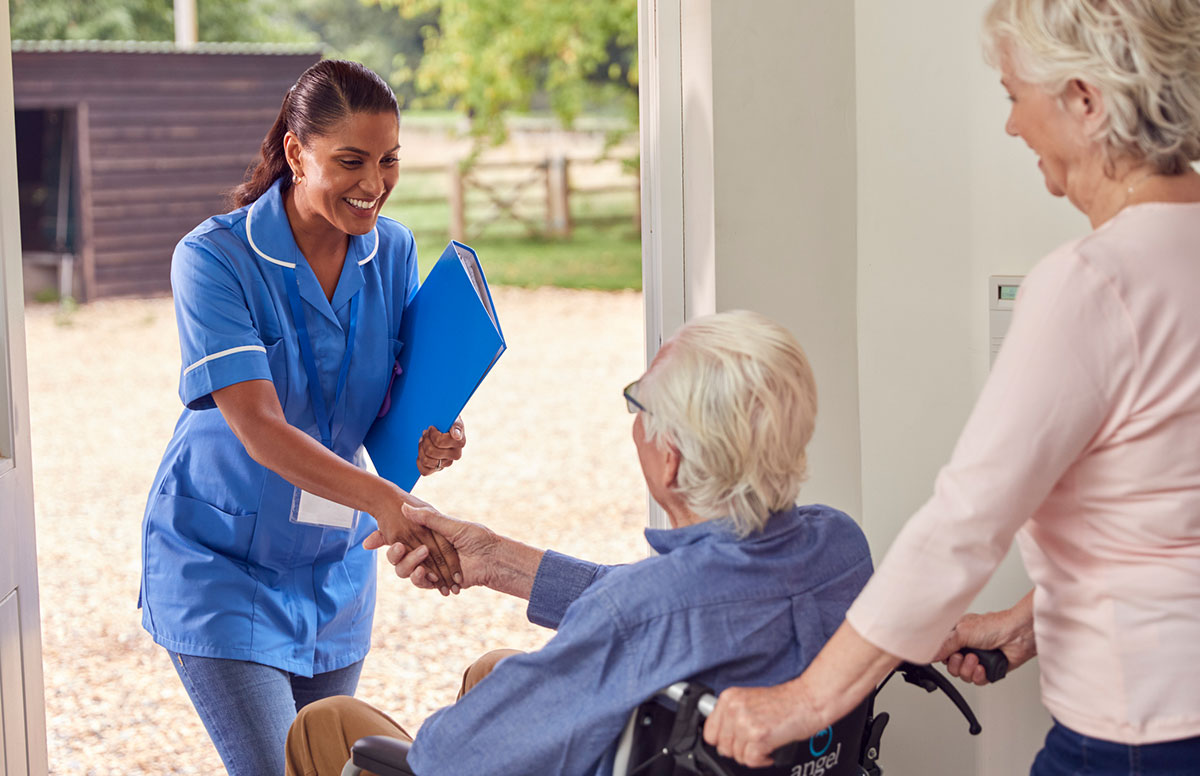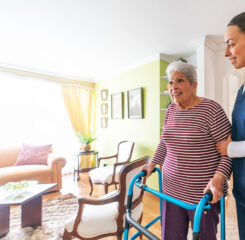CMS Issues Big Changes to Visitation Guidance
On November 12, the Centers for Medicare & Medicaid Services (CMS) issued updated guidance that nearly returns nursing home visitation to pre-pandemic practices. Effective immediately, nursing home visitation is now available to all residents at all times in according with requirements at 42 CFR §483.10(f)(4) Resident Rights. Nursing homes are no longer required to restrict visitation during outbreak investigations or for residents who are on transmission-based precautions due to active COVID-19 infection or identification as a “close contact” of someone with COVID-19 infection. The guidance also outlines appropriate changes to dining, activities, and resident outings.
These welcome changes are due largely to high levels of vaccination among residents, increasing vaccination among staff, and declines in COVID-19 cases in nursing homes. While many COVID-era practices will remain, incorporating these practices into normal operations is the clear path forward.
Core Principles of COVID-19 Infection Prevention
Recognizing that these principles have become an accepted part of normal operations for the foreseeable future, it feels worthwhile to review for clarity. These core principles, identified by CMS and consistent with guidance from the Centers for Disease Control & Prevention (CDC) include:
- Screening for all who enter the nursing home. Visitors with a positive viral test, signs or symptoms of COVID-19, or who meet the criteria for quarantine should not enter the nursing home.
- Regular hand hygiene. Alcohol-based hand rub is preferred in most circumstances.
- Face masks and physical distancing in accordance with CDC guidance.
- Instructional signage and education on COVID-19 signs and symptoms, infection control precautions, and other applicable practices determined by the nursing home such as specified entries, exits, and routes to designated areas, etc.
- Frequent cleaning and disinfection of high-touch surfaces and cleaning and disinfection of designated visiting areas after each visit.
- Appropriate staff use of personal protective equipment (PPE).
- Effective cohorting of residents.
- Testing of residents and staff according to requirements.
Individuals who are unwilling or unable to adhere to core principles of infection prevention, even after instruction and assistance from the nursing home, may be restricted from the nursing home.
Visitation
Visitation is now permitted for all residents at any time in accordance with 42 CFR §483.10(f)(4). While CMS states that outdoor visitation remains the preferred method of visitation for residents and/or visitors who are not fully vaccinated, these individuals are not limited to outdoor visitation.
Nursing homes may no longer limit the number of visitors, frequency of visits, or length of visits. Nursing homes may not require scheduling of visits; however, nursing homes must continue to ensure that appropriate physical distancing can occur during visits. This means that large gatherings or events during which physical distancing cannot be maintained is discouraged. Visits may take place in resident rooms or in a designated visiting space. If a resident’s roommate is unvaccinated or is immunocompromised regardless of vaccination status, visits should not take place in that resident’s room. Visitors should additionally limit movement within nursing home, going directly to the resident’s room or visiting space.
Source control (masking) and physical distancing should be observed as follows:
- In areas of substantial to high community transmission: residents and visitors should wear face masks and practice physical distancing at all times regardless of vaccination status.
- In areas of low to moderate community transmission: residents and visitors are recommended to wear face masks and practice physical distancing, especially if either the resident or the visitor is unvaccinated or at risk for severe disease. If both the resident and visitor are fully vaccinated and none are at risk for severe disease, the resident and visitor may choose to remove face masks and forego physical distancing during the visit.
- The CDC’s COVID Data Tracker – County View should be used to determine community transmission rates.
- Visitors must wear face masks and physical distance from other residents and staff at all times regardless of vaccination status.
Visitation During Outbreak
Indoor visitation may occur for all residents at all times, including while the nursing home is investigating or experiencing an outbreak. Visitors should be notified of the outbreak and the risks associated with visiting. Visitation should take place in the resident’s room and residents and visitors must wear face masks regardless of vaccination status.
While not recommended, CMS has stated that residents on transmission-based precautions may now receive visitors. Visitors should be notified of the risks associated with visiting. Visitation should take place in the resident’s room and residents must wear face masks. The nursing home may offer the visitor personal protective equipment for the duration of the visit but are not required to do so.
Visitor Testing and Vaccination
Nursing homes may offer or ask about visitor status of both testing and vaccination. Visitor testing is encouraged in areas of high to substantial community transmission, but not required. Nursing homes may offer testing to visitors and/or encourage visitors to be tested during the 2-3 days prior to the visit. Nursing homes may also offer education on vaccination.
Nursing homes may not restrict visitors who decline testing or vaccination or who fail to show proof of testing or vaccination. Visitors who decline to disclose vaccination status must wear a face covering at all times.
Activities, Dining, and Resident Outings
Source control and physical distancing are recommended for all, regardless of vaccination status, in common areas. Residents should be permitted to leave the nursing home as they choose and reminded to adhere to core principles of infection prevention while on leave.
Upon return, the nursing home must screen the resident and may choose to test unvaccinated residents upon return if they leave frequently or are out of the nursing home for more than 24 hours. Any residents who are out of the nursing home for longer than 24 hours should be regarded as a new admission / readmission according to CDC guidance.
Upon return from an outing, the nursing home should test the resident if the resident reports close contact with an individual with COVID-19. Unvaccinated residents with close contact should be placed on transmission-based precautions and quarantine. The nursing home may also choose to place on quarantine any unvaccinated residents for whom there is doubt about adherence to core principles of infection control on behalf of either the resident or those with whom the resident interacted during the outing.
Surveyor Entry
Nursing homes should screen surveyors as any other visitor and may offer surveyors testing or inquire about vaccination; however, nursing homes may not require either testing or proof of vaccination as a condition of entry. At this time, it is unclear what vaccination protocols a surveyor may be subject to. CMS states that any questions about the process used to ensure surveyors are safe to enter the nursing home should be referred to the State Survey Agency.
What This Means for Nursing Homes
These changes bring nursing homes the closest to pre-pandemic operations that they have been since March 2020. LeadingAge encourages members to continue educating residents and visitors on COVID-19 and best practices to mitigate transmission and spread, including vaccination.
Remember to check with state and local public health on any additional requirements or recommendations related to visitation in nursing homes. It will be essential to clearly communicate expectations for safety to all residents, visitors, and staff. Working collaboratively with residents, visitors, and staff will help ensure adherence to core principles of infection control while celebrating the resident’s right to visitors.

Most Recommended
October 15, 2025
 Shutdown Week Three: Impact of Ongoing Closure on Affordable Housing
Shutdown Week Three: Impact of Ongoing Closure on Affordable Housing
December 10, 2025
Fiscal Year (FY) Funding 2026
October 07, 2025
Immigrant Workforce Matching Program Brings Workforce Relief
Recently Added
January 07, 2026
Nominate a Growing Leader for the 2026 LeadingAge Leadership Award
January 07, 2026
 Colleagues on the Move, January 7, 2026
Colleagues on the Move, January 7, 2026
December 29, 2025
 RHT Program Awards: All 50 States To Receive Funds, Says CMS
RHT Program Awards: All 50 States To Receive Funds, Says CMS
December 29, 2025



